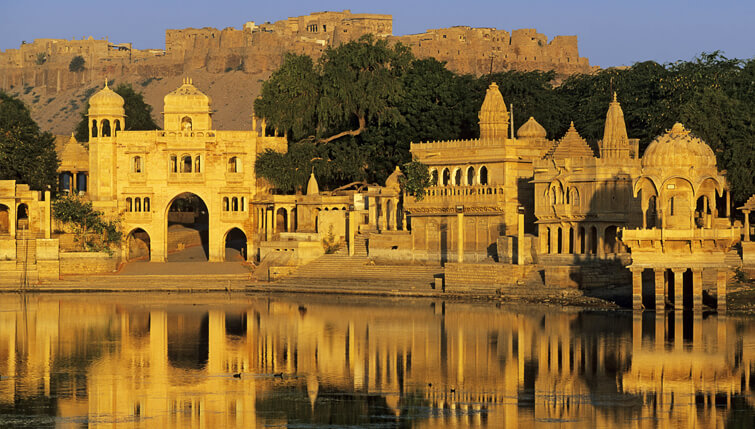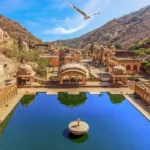The Top 10 Heritage Places in Rajasthan: A Journey Through Time
Rajasthan, India’s largest state, is a treasure trove of history, culture, and architectural elegance. Known as the “Land of Kings,” this vibrant region boasts a rich heritage that spans centuries. From majestic forts and palaces to ancient temples and bustling bazaars, Rajasthan offers an enchanting glimpse into India’s royal past. Let’s embark on a journey through the top 10 heritage places in Rajasthan, each a testament to the grandeur and tradition of this extraordinary state.
1. Amber Fort, Jaipur
Perched on a hilltop overlooking Maota Lake, Amber Fort is a stunning example of Rajput architecture. Constructed in the 16th century by Raja Man Singh I, the fort is a blend of Hindu and Mughal styles, featuring intricate carvings, sprawling courtyards, and spectacular mirror work. The Sheesh Mahal (Mirror Palace) within the fort is particularly impressive, with its walls adorned with hundreds of tiny mirrors that reflect light in a dazzling display. The fort’s grand entrance, the Suraj Pol, leads to a labyrinth of halls, gardens, and temples, offering a glimpse into the opulent lifestyle of the Rajput rulers.
2. City Palace, Udaipur
Overlooking the serene waters of Lake Pichola, the City Palace in Udaipur is a marvel of marble and granite. Built by Maharana Udai Singh II in the 16th century, this palace complex is a fusion of Rajasthani, Mughal, and European architectural styles. The City Palace is an expansive complex of courtyards, gardens, and buildings that reflect the rich history and culture of Udaipur. The intricate peacock mosaics in the Mor Chowk, the stunning mirror work in the Sheesh Mahal, and the panoramic views from the palace’s balconies make it a must-visit destination for history enthusiasts and architecture lovers alike.
3. Jaisalmer Fort, Jaisalmer
Known as the “Golden Fort” due to its golden-hued sandstone walls, Jaisalmer Fort is one of the largest living forts in the world. Built in 1156 AD by Rawal Jaisal, this UNESCO World Heritage Site is a unique blend of Rajput and Islamic architectural styles. The fort’s narrow lanes are lined with intricately carved havelis, Jain temples, and bustling markets, offering a vibrant glimpse into the daily life of the city’s residents. The fort’s strategic location on Trikuta Hill provides breathtaking views of the surrounding Thar Desert, making it a popular destination for tourists and photographers.
4. Mehrangarh Fort, Jodhpur
Rising majestically above the city of Jodhpur, Mehrangarh Fort is one of the most impressive and well-preserved forts in India. Founded by Rao Jodha in 1459, the fort’s imposing walls enclose a complex of palaces, courtyards, and museums. The fort’s architecture is a blend of Rajput and Mughal styles, with intricately carved stone lattices, expansive courtyards, and stunning views of the city below. The museum within the fort houses a remarkable collection of artifacts, including royal costumes, weapons, and paintings, providing a fascinating insight into the history and culture of the Rathore dynasty.
5. Chittorgarh Fort, Chittorgarh
The largest fort in India, Chittorgarh Fort is a symbol of Rajput valor and sacrifice. Spanning over 700 acres, the fort is perched on a hill overlooking the Berach River. Built in the 7th century, the fort has witnessed numerous battles and sieges, earning it a place in the annals of Indian history. The fort complex includes several palaces, temples, and towers, each with its own story to tell. The Vijay Stambh (Victory Tower) and Kirti Stambh (Tower of Fame) are iconic structures within the fort, showcasing intricate carvings and architectural brilliance. The fort’s history is also marked by the legendary tales of Rani Padmini’s beauty and the heroic sacrifice of the Rajput warriors.
6. Hawa Mahal, Jaipur
The iconic Hawa Mahal, or “Palace of Winds,” is a five-story pink sandstone structure that stands as a symbol of Jaipur’s rich architectural heritage. Built in 1799 by Maharaja Sawai Pratap Singh, the palace was designed by Lal Chand Ustad to allow the royal ladies to observe daily life and festivities on the street below without being seen. The palace’s unique honeycomb design features 953 small windows, known as jharokhas, adorned with intricate latticework. The cool breeze that flows through these windows gave the palace its name, making it a perfect retreat during the scorching summer months.
7. Ranthambore Fort, Sawai Madhopur
Situated within Ranthambore National Park, Ranthambore Fort is a UNESCO World Heritage Site known for its historical and architectural significance. The fort dates back to the 10th century and has witnessed the rise and fall of several dynasties. The fort’s strategic location on a hilltop offers panoramic views of the surrounding jungle, which is home to a rich variety of wildlife, including the majestic Bengal tiger. The fort complex includes temples, mosques, and palaces, with the Trinetra Ganesh Temple being a major attraction for devotees and tourists alike.
8. Junagarh Fort, Bikaner
Unlike many forts in Rajasthan, Junagarh Fort was not built on a hilltop but on the plains of Bikaner. Constructed in the late 16th century by Raja Rai Singh, the fort is a fine example of Rajput architecture with a mix of Gujarati and Mughal influences. The fort complex includes several palaces, courtyards, and museums that offer a glimpse into the royal lifestyle of the Bikaner rulers. The Karan Mahal, Phool Mahal, and Anup Mahal are notable for their exquisite frescoes, mirror work, and intricate carvings. The fort’s rich history and architectural beauty make it a must-visit destination for history enthusiasts.
9. Kumbhalgarh Fort, Rajsamand
Kumbhalgarh Fort, a UNESCO World Heritage Site, is renowned for its massive walls that stretch over 36 kilometers, making it the second-longest wall in the world after the Great Wall of China. Built in the 15th century by Rana Kumbha, the fort is nestled in the Aravalli Range and offers breathtaking views of the surrounding landscape. The fort complex includes palaces, temples, and step-wells, with the Badal Mahal being a standout feature for its stunning views and unique design. The fort’s strategic location and formidable defenses made it a key stronghold in the history of Mewar.
10. Bundi Palace, Bundi
Bundi Palace, perched on a hill overlooking the town of Bundi, is a hidden gem in Rajasthan’s rich tapestry of heritage sites. The palace is known for its stunning murals and frescoes, which depict scenes from Hindu mythology and the life of the royal family. The Chitrashala, or “Hall of Paintings,” is particularly famous for its vibrant paintings that showcase the artistic prowess of the Bundi school of painting. The palace’s architecture reflects a blend of Rajput and Mughal styles, with ornate balconies, intricately carved columns, and beautiful courtyards. The Taragarh Fort, located above the palace, offers panoramic views of the town and the surrounding landscape.
Conclusion
Rajasthan’s rich heritage is a testament to the state’s glorious past and vibrant culture. From the grandeur of its forts and palaces to the intricate artistry of its temples and havelis, the heritage sites of Rajasthan offer a fascinating journey through time. Each site tells a unique story of bravery, romance, and artistic brilliance, making Rajasthan a must-visit destination for history enthusiasts and cultural explorers alike. Whether you’re exploring the bustling streets of Jaipur, the serene lakes of Udaipur, or the golden sands of Jaisalmer, Rajasthan promises an unforgettable experience that will leave you enchanted by its timeless charm.
For more information and to plan your visit, check out our Rajasthan Tour Packages.



